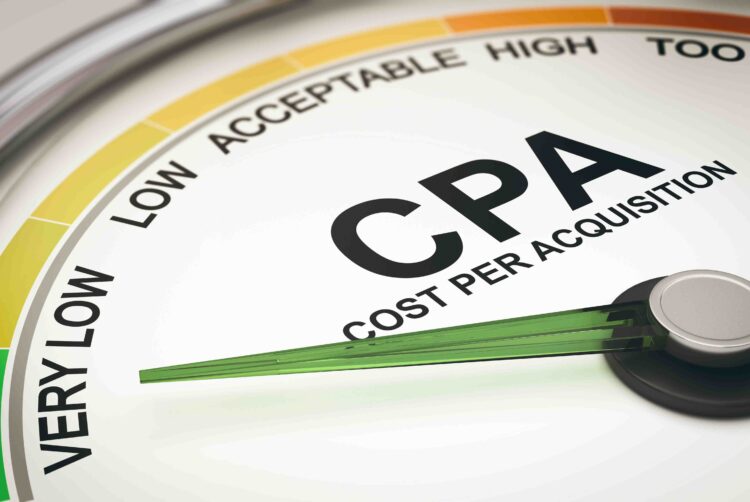Performance planning: what you need to know about cost per acquisition

Opinion
In the latest of this digital-media planning series, we’re going to fiddle about with another lever to improve performance: the cost per acquisition.
Following our previous instalments, I’m sure you’ve been eagerly playing along at home, redistributing your budget to hit the POMY (and if you don’t know what POMY is, I suggest you recap our last chat) and you’re now satisfied that your channel-specific budgets are in the right region to avoid diminishing returns.
Now that we’re comfortable we’ve allocated an appropriate level of budget to each channel, we’re going to fiddle about with another lever to improve performance: the cost per acquisition, or CPA*.
(*also known as CPL, CPE, CPConv – whether your end goal is a purchase, a subscription, a page visit etc, we’ll be referring to your cost-per-the-thing-you-want-people-to-do as ‘CPA’ for ease.)
For the avoidance of doubt, your CPA is directly impacted by your costs and your number of ‘acquisitions’. In order to improve the CPA you’re achieving, you can decrease your costs, or increase your number of acquisitions (or a mix of the two).
In many instances where CPA is too high, the full allocated budget is being spent and so it’s impossible to fit any more acquisitions into the budget: the only way to receive a higher number of acquisitions within our budget is to decrease how much we’re spending on each media unit (e.g. a click, 1,000 impressions, a video view), or to decrease media spend that didn’t correlate to an acquisition, and would be considered ‘wastage’.
And as ever, I have a handy diagram for you. In this instance I have used Search as the example:

The above framework shows the stage in the consumer journey/process, the metrics which are impacted at each stage, and the correlating assets.
For example, if we want to improve conversion rate, adjustments will need to be made to the landing page or conversion journey, as changes to an any other asset such as the ad copy is unlikely to make a difference.
If, however, you’re keen to attract a higher volume of traffic, optimisations should take place at the keyword or ad copy stages.
To decrease our CPA on Search (on the assumption that we’re not able to attract a higher volume of acquisitions within our budget), you may find the following optimisations to be effective in reducing your overall spend:
– Tighten your keyword match types to exact or phrase match; this reduces potential for irrelevant terms triggering your ads
– Remove keywords which are receiving traffic and therefore incurring cost, however have not received conversions. As a further step, negative keywords should be implemented to pre-emptively exclude unlikely-to-convert traffic
– Review your audience and targeting (time of day, day of week, device, location, language, demographic etc) for any dimensions dragging efficiency down (e.g. you may have an average CPA of £30 but the CPA for desktop is £80). Assess whether that criterion should still be targeted, or whether a bid adjustment will help to balance the cost vs return.
The other aspect to consider is the Search Quality Score function, the salient basis of which being: the higher your relevance between keyword/ad copy/landing page, the lower your unit cost (CPC).
The strong correlation between relevance/quality score and unit costs means that wasted budget can manifest itself in inflated unit cost as well as the more obvious wastage.
 Niki Grant
Niki GrantTo reduce unit cost, you’ll need to appeal to the algorithmic side of Google and take every opportunity to demonstrate strong relevance (through your keywords also featuring appropriately in ad copy with relevant content waiting on the landing page), engagement (by way of click-through rate), and positive user experience (landing page load times, quality of landing page content).
To reduce your unit cost on Search, you should primarily consider the your keyword strategy and whether these target terms accurately reflect the content on your site and in your ad copy.
Even more variables
Whilst the reduction of wasted budget follows a very similar theory across all channels, the unit cost optimisation differs based on the buying model or algorithm.
I checked in with Gabriella Kite, The Kite Factory’s head of digital operations, and Jack Shearman, senior programmatic executive, to get the skinny on social and display mechanisms.
Gabby’s recommendation for social unit cost optimisation is to focus primarily on your audience:
“Audience size is generally the biggest factor in the inflation of social unit cost. The broader your audience, the lower your CPM is likely to be, however with a broader audience the lower unit cost could be negated by lower audience relevance (depending on your KPIs and aims).
“An additional audience nuance is overlap. if you are targeting the same mid-small audience in several campaigns then you can nudge up the cost. The audiences aren’t technically in direct competition, however they will be considered by Facebook within the same auction if the same audience is being targeted across two ad sets. Facebook manage this by serving the better-performing ad set against the target audience (much the same as Google would with duplicate keywords), leading to decreased delivery within your competing ad set. This reduction in delivery for the (already lesser-perfoming) ad set you reduces the number of valuable impressions available, which can increase your costs indirectly.
Similar to Google, Facebook used to provide a ‘relevance score’, however this has been replaced with three value metrics: Bid, Estimated Action Rates, and Ad Quality.”
It’s worth considering that Facebook’s view of ‘ad quality’ will come from different signals to that of Google, including ad-viewers hiding the ad, or exhibiting ‘low quality’ behaviours, such as withholding information, or the use of ‘engagement bait’.
There are even more variables when it comes to display, according to Jack:
“Within display channels we will often have a number of creative messaging variations along with multiple sizes of placement. We would look to upweight and bid higher on particular messages driving the lowest CPA. After analysing the reach and CPM of the different sizes we may look to bid higher on a certain placement providing the greatest conversions. It is key to ensure that, as each size has a different cost and amount of available inventory, we aren’t impacting the overall scale, pace and efficiency of the campaign with creative changes.
Due to the nature of Display media, various DSPs and tech partners are utilised, and these can sometimes overlap, causing a brand to compete against themselves, leading to a decrease in efficiency. By reviewing top conversion paths, advertisers can assess not only the impact of Display earlier on in the funnel (as opposed to a last—click CPA), but identify and remove any partner delivery overlap.”
And with this, we conclude with this month’s to-do list:
- Segment campaign performance by targeting criteria and identify segments which under or overperform. Exclude or assign bid adjustments accordingly.
- Review your creative within the realms of its relevance to the landing page; ensure clear threads of relevance are pulled through each campaign asset and be sure to identify performance variances between placement size and format.
- Review your targeting/placement criteria across campaigns to ensure you’re not competing against yourself in any of your media buys.
Until next time…
Niki Grant is search director at The Kite Factory. Check out her previous instalments of Performance Planning, a guide for marketers and media planners to handle performance media planning and budget optimisation and her other columns for The Media Leader.
Strategy Leaders: The Media Leader‘s weekly bulletin with thought leadership, news and analysis dedicated to excellence in commercial media strategy.
Sign up for free to ensure you stay up to date every Tuesday.



